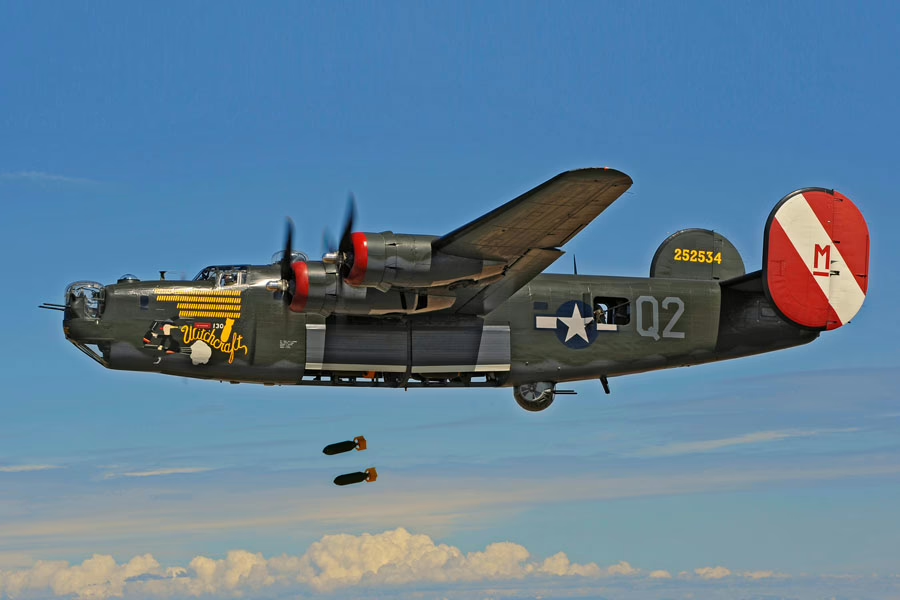Consolidated B-24 Liberator History
To the Consolidated B-24 Liberator go the distinctions of being built in greater numbers and more variants than any other U.S. aircraft of World War Two, and of serving in more combat theatres, over a long period, than any heavy bomber on either side. It originated as the Consolidated Model 32, a major feature of which was the exceptionally high aspect ratio Davis wing that gave the Liberator its prodigious range.
Conceived five years after the Boeing B-17 Flying Fortress it did not, in fact, notably improve on the older bomber’s performance and in respect of engine-out performance and general stability and control it was inferior, being a handful for the average pilot. The B-24 Liberator was by far the most complicated and expensive combat aircraft the world had seen – though in this it merely showed the way things were going to be in future. Yet it was built in bigger numbers than any other American aircraft in history. In terms of industrial effort it transcended anything seen previously in any sphere of endeavour.
The sole XB-24 prototype flew on 29 December 1941, followed by YB-24 service trials aircraft and thirty-six production B-24As. One hundred and twenty were also ordered by the French Government, but these were diverted to Britain.
Early Consolidated B-24 Liberator versions supplied to the RAF were judged not combat-ready, and they began the Atlantic Return Ferry Service as LB-30A transports. Better defences led to the RAF Liberator I, used by Coastal Command with ASV radar and a battery of fixed 20 mm cannon. The RAF Liberator II (B-24C) introduced power turrets and served as a bomber in the Middle East. The first mass-produced version was the B-24D, with turbocharged engines in oval cowls, more fuel and armament and many detail changes; 2,738 served US Bomb Groups in Europe and the Pacific, and RAF Coastal Command closed the mid-Atlantic gap, previously beyond aircraft range, where U-boat packs lurked.
In mid-1943 those USAAF B-24Ds engaged on anti-submarine patrol were redesignated PB4Y-1. Seven hundred and ninety-one B-24Es were built by Convair (as Consolidated was now known), Douglas and the Ford Motor Co, distinguishable from the D model chiefly by their modified propellers; while North American contributed four hundred and thirty B-24Gs.
The Consolidated B-24 Liberator, although sharing a substantial part of the bombing of the Europe with its contemporary, the Boeing Fortress, was even more prominent in the Pacific theatre, where its excellent range was particularly valuable.
In addition to those serving with the U.S. forces and RAF, considerable numbers also operated with the Canadian and other Commonwealth air forces. When Consolidated B-24 Liberator production ended on 31 May 1945 the total output of all variants had reached eighteen thousand one hundred and eighty-eight aircraft.
Consolidated B-24 Liberator Specifications
| Aircraft Type: |
| bomber airplane |
| Dimensions: |
| wingspan: 100 ft |
| length: 67 ft, 2 in |
| height: 17 ft, 11 in |
| Weights: |
| empty: 36,500 lb |
| gross: 56,000 lb |
| Power plant: |
| 4 × 1,200 hp Pratt and Whitney R1830 supercharged radial engines |
| Performance: |
| maximum speed: 303 mph |
| ceiling: 28,000 ft |
| maximum range: 3,700 mi |
| Armament: |
| 10 × 0.50 in calibre machine guns |
| 8,000 lb of bombs |
| Operational Use: |
| 1940–1950 |










